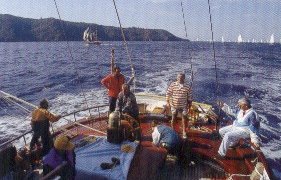Blessed
with the love of Aphrodite
Blessed
with the love of Aphrodite
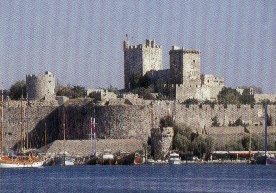 Bodrum,
on the north shore of the Gulf of Gokova, was the home of the first
"Blue Voyager", Cevat Sakir Kabaagac or the "Fisherman of
Halikarnas". It is the undisputed "hot-spot" of the Aegean Coast.
This swinging, singing, dancing town, with its bohemian atmosphere,
gathers together Turkey's artists, intellectuals and lovers of the
good life.
Bodrum,
on the north shore of the Gulf of Gokova, was the home of the first
"Blue Voyager", Cevat Sakir Kabaagac or the "Fisherman of
Halikarnas". It is the undisputed "hot-spot" of the Aegean Coast.
This swinging, singing, dancing town, with its bohemian atmosphere,
gathers together Turkey's artists, intellectuals and lovers of the
good life.
An impressive medieval castle built
by the Knights of Rhodes guards the entrance to Bodrum's dazzling
blue bay, in which the Aegean and the Mediterranean Seas meet. The
Bodrurn Castle now houses the  Museum
of Underwater Archaeology Known in ancient times as Halicarnassus,
Bodrum is the birthplace of Heredotus and the site of King Mausolus's
Tomb (4th century B.C.), one of the Seven Wonders of the ancient
world. The yearly throng of visitors has encour-aged small
entrepreneurs who have made shopping in Bodrum a delight. Souvenirs
abound, and on certain streets local artists gather to sell their
works - works that come in all forms.
Museum
of Underwater Archaeology Known in ancient times as Halicarnassus,
Bodrum is the birthplace of Heredotus and the site of King Mausolus's
Tomb (4th century B.C.), one of the Seven Wonders of the ancient
world. The yearly throng of visitors has encour-aged small
entrepreneurs who have made shopping in Bodrum a delight. Souvenirs
abound, and on certain streets local artists gather to sell their
works - works that come in all forms.
The Bodrum Turban Marina is one of the loveliest and best-equipped marinas in the region.
A yachting tour of the Gulf of Gokova
starts in Bodrum. The translucent and deep waters of the Gulf on the
southern shore of the Bodrum Peninsula vary from the darkest blue to
the palest turquoise, and the coastline is thickly wooded with every
hue of green. In the evening, the sea reflects the mountains
silhouetted against the setting sun, while at night it shimmers with
phosphorescence.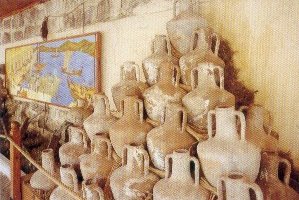
One of the best anchorages is the splendidly scenic Akbuk, hidden behind a forested promontory The excellent cozy restaurants are as good a reason as any to linger for a tasty meal after an afternoon of snorkeling and diving. Sedir Island (ancient Cedrai) boasts an incredible beach with fine sand composed of fossils, and a splendid view of the Kiran mountains across the bay As you sail along the island's southwestern coast, forests stretch out to meet the deep inlets of the bays. The jagged coastline, known as the flay of Sixty-Six Inlets, seems to have emerged from the oft-told tales of pirates.
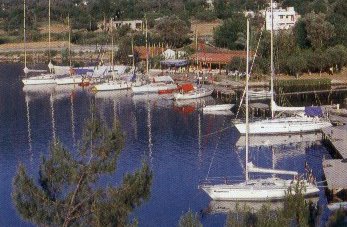 The
waters of the Gulf of Hisaronu lap the breathtaking shores that hold
the legacy of both ancient and modern civilizations. At the end of
the Datca Peninsula stands the ancient Carian city of Knidos,
described by Strabo as "a city that was built for the most beautiful
of goddesses, Aphrodite, on the most beautiful of peninsulas." Famous
as a center of art and culture in the fourth century B.C., the city
had two harbors: one on the Aegean and the other on the
Mediterranean. The remains of a circular temple dedicated to the
goddess of love overlook remains of the two harbors; the arcaded way
was built of white marble heart-shaped columns. The legendary
Aphrodite of Praxiteles statue, reputedly one of the most beautiful
sculptures of antiquity once graced this temple. The town of Datca
has become a popular stopover for yachtsmen, and offers many colorful
seafood restaurants, pubs and discotheques.
The
waters of the Gulf of Hisaronu lap the breathtaking shores that hold
the legacy of both ancient and modern civilizations. At the end of
the Datca Peninsula stands the ancient Carian city of Knidos,
described by Strabo as "a city that was built for the most beautiful
of goddesses, Aphrodite, on the most beautiful of peninsulas." Famous
as a center of art and culture in the fourth century B.C., the city
had two harbors: one on the Aegean and the other on the
Mediterranean. The remains of a circular temple dedicated to the
goddess of love overlook remains of the two harbors; the arcaded way
was built of white marble heart-shaped columns. The legendary
Aphrodite of Praxiteles statue, reputedly one of the most beautiful
sculptures of antiquity once graced this temple. The town of Datca
has become a popular stopover for yachtsmen, and offers many colorful
seafood restaurants, pubs and discotheques.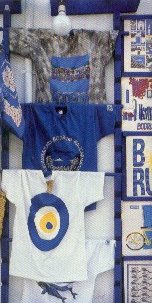
In the Gulf of Hisaronu is the peaceful Keci Buku Bay; the Bay Marina is rich in natural beauty: the surrounding mountains and forests, and the long "Kizkumu" (sunken 'pier'), a natural sand formation. Leaving the Gulf of Hisaronu, hidden away in its own exclusive inlet is the town of Bozburun, famous as one of the gulet-building centers of Turkey Loryma, at the tip of the Bozburun Peninsula where the ruins of the ancient harbor and castle remain, can only be reached by boat. Kumlubuk, a turquoise paradise, lies on the southern side of the bay; on the north side, above the water, stands the ancient Rhodian city of Amos. At Turunc a natural harbor opens out into a wide expanse of spectacular blue water. The next port is Marmaris.
